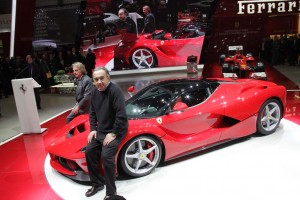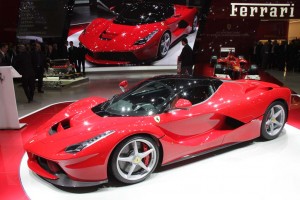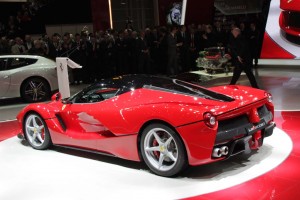If your idea of a hybrid looks something like the Toyota Prius, something that’s more fuel-efficient than fun-to-drive, you may need an attitude readjustment after getting a look at the new LaFerrari, the long-awaited replacement for the Italian automaker’s former flagship, the Enzo.
This is definitely not your typical gas-electric drivetrain, though the maker insists it will substantially reduce emissions and fuel consumption compared to a conventional drivetrain. Of course, there aren’t many out there that can churn out to nearly 1,000 horsepower.
During a presentation at the Geneva Motor Show, Ferrari President Luca di Montezemelo described the new model as the “maximum expression of what defines our company….all the capabilities of our know-how,” adding that the LaFerrari “represents the future” for one of the world’s most respected sports car manufacturers.
The new, limited-edition 2-seater will be the fastest and most powerful car Ferrari has ever designed for the street, capable of launching from 0 to 100 kmh, or 62.5 mph, in less than 3 seconds, and 186 mph in 15 seconds, or about the time it would take a Prius to hit 75 mph.
To get there, Ferrari turned for help to its Formula One race teams for guidance – and quite a bit of the technology found in the new “ultracar.” That includes a body and chassis made all but entirely out of super-light carbon fiber, as well as an active aerodynamic system that can automatically adjust key body panels to reduce wind resistance or increase downforce at extreme speeds.
Then there’s the HY-KERS, or hybrid kinetic energy recovery system. On the track, it does much the same thing as more conventional hybrid technology, recapturing energy normally wasted during braking. Coming out of a corner, that provides a huge burst of power to assist an F1 car’s gas engine — though it lasts for just a matter of seconds. In La Ferrari, HY-KERS also will assist the conventional, 6.3-liter non-turbo V-12 gasoline engine mated to a 7-speed dual-clutch transmission.

Ferrari President Luca di Montezemelo and parent Fiat's CEO Sergio Marchionne after the LaFerrari unveiling.
Capable at reaching 9,000 RPMs, it’s already rated at a sizzling 800 horsepower, but when the hybrid electric motor kicks in, drawing power from a 130-pound lithium-ion battery, that jumps to an astonishing 963 hp, making La Ferrari one of the most powerful cars ever put on the street.
The system is also designed to help reduce fuel consumption, among other things, using a second electric motor to reduce the demand on the V-12 by powering La Ferrari’s air conditioner and other accessories.
The overall design draws inspiration from the older Enzo, which drew its name from the maker’s legendary founder, Enzo Ferrari. But the car looks like it could readily shift over to the track. Indeed, the interior is very much the race car, with a surprisingly simple design for such an expensive vehicle that makes it clear this is all about ultimate performance.
Like an F1 racer, the seat is mounted in a fixed position — Ferrari planning to customize each seat for the individual customer – and, instead, the pedals and steering wheel move.
Montezemelo revealed that only 499 copies of the Ferrari will be produced, “which will be tough for us,” he said, because the maker has already received 700 strong inquiries.
While the use of the HY-KERS system is a revolutionary departure for Ferrari, the La Ferrari is by no means entirely unique. British supercar maker McLaren is turning to a hybrid for its own, limited-edition ultracar, the P1, which was also introduced at this year’s Geneva Motor Show. Porsche has a number of hybrid models in the works, as well as a plug-in hybrid version of its Panamera sports sedan.
(For more on the McLaren P1, Click Here.)
Conventional hybrid automobiles usually tack on a modest premium for the added technology. There’s nothing modest about La Ferrari, including the price tag, which is expected to top $1.3 million.



The will be nice museum pieces.